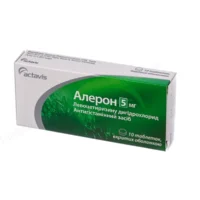Description
Allertek (Cetirizine) Coated Tablets 10 mg
Composition
Active Ingredient: Each tablet contains Cetirizine 10mg.
Mechanism of Action
Cetirizine, a second-generation antihistamine, selectively inhibits peripheral H1 receptors, effectively blocking the action of histamine responsible for allergic symptoms.
Pharmacological Properties
Cetirizine acts by reducing symptoms like itching, sneezing, and runny nose associated with allergies through H1 receptor inhibition. Its once-daily dosing provides convenient and long-lasting relief.
Indications for Use
Allertek (Cetirizine) Coated Tablets are indicated for seasonal and perennial allergic rhinitis symptoms, including sneezing, runny nose, itchy/watery eyes, and throat/nose itching.
Contraindications
Avoid use if allergic to Cetirizine or other antihistamines to prevent adverse reactions.
Side Effects
Common side effects may include drowsiness; caution advised when driving or operating machinery. Consult a healthcare provider for guidance, especially with existing medical conditions or other medications.
Usage Instructions
Recommended Dosage: Adults and children over 6 years should take 1 tablet daily, with or without food. Swallow whole with water; do not chew or crush.
Benefits Over Analogs
Allertek (Cetirizine) offers effective symptom relief with minimal sedation compared to first-generation antihistamines, enhancing patient comfort and compliance.
Suitable Patient Groups
Safe for use in adults and children over 6 years; caution advised in elderly populations and individuals with specific medical conditions.
Storage and Shelf Life
Store in a cool, dry place away from direct sunlight. Check the packaging for the expiry date; do not use expired tablets.
Packaging Description
Allertek (Cetirizine) Coated Tablets are available in a pack of 7 tablets, each containing 10mg of Cetirizine.
Clinical Evidence and Effectiveness
Clinical studies have shown the efficacy of Cetirizine in relieving allergic rhinitis symptoms, with a low sedation risk compared to first-generation antihistamines. Comparative trials have demonstrated its effectiveness similar to other second-generation antihistamines, with a favorable side effect profile.





